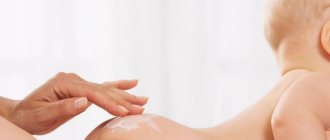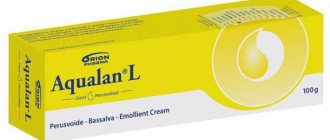What are emollients?
Emollients are fats and fat-like substances. They are included in cosmetic products created to care for dry, damaged skin. Emollients are also used for dermatitis in children. After using this product, the skin remains moisturized and soft longer. It is less susceptible to traumatic factors: friction with clothing, sweat, tap water, soap, washing powder, low temperature, sun rays.
The use of emollient reduces the risk of bacterial infection of the affected skin by improving its barrier properties.
How do emollients work for atopic dermatitis?
The skin of children suffering from atopic dermatitis has a special structure. It lacks a binding protein and does not form a full protective lipid layer. Such skin loses a lot of moisture, becomes dry, peels, and cracks. Allergens and pathogenic microorganisms penetrate through an imperfect skin barrier. This leads to the appearance of signs of inflammation: redness, itching, cracks, weeping, ulcers.
For many years, scientists have tried to “cure” this defective lipid layer, linking its development to food allergies or intestinal conditions. And only in recent decades has it become clear that changes in the structure of the skin are a genetic feature and cannot be cured. All that remains is to help the skin cope with its function. This is where emollients are needed. Since the skin itself cannot create a lipid barrier, you need to create it artificially using cosmetics.
When applied to the skin, emollient creates a thin film similar in structure to the natural lipid layer. This prevents moisture loss and protects the skin from exposure to traumatic factors. According to the latest clinical guidelines, the use of emollients is the mainstay of treatment for children with atopic dermatitis.
Correct use of emollients allows you to:
- reduce the frequency of exacerbations, or prevent them altogether;
- reduce the need to use steroid, antibacterial and antihistamine drugs;
- reduce subjective sensations: itching, peeling, skin tightness;
- accelerate the healing of small wounds and cracks;
- reduce the risk of fungal or bacterial infection;
- According to recent studies, the use of emollients may reduce the risk of developing allergic and autoimmune diseases in the future.
Reasons for development
The natural chemical composition of the secretion of the sebaceous glands of the skin contains linolenic acid. It prevents the proliferation of fungi. When the function of the sebaceous glands is impaired (hypo- or hyperfunction), pathogenic microorganisms, including fungi, begin to develop on the skin. They are present on the surface of the skin and are normal, but in small quantities. When the pH of the skin changes, fungi begin to multiply and negatively affect the skin epithelium.
The reasons for the development of seborrheic dermatitis include the following factors:
- proliferation of the yeast-like fungus Malassezia, which changes the composition of the skin microflora;
- prolonged exposure to stress;
- hormonal disorders, which often occur in adolescence, with malfunctions of the thyroid gland;
- adverse environmental influences (for example, water quality, dry indoor air during the heating season, sudden changes in climatic conditions);
- taking certain medications, using cosmetics that cause skin irritation;
- dysfunction of the gastrointestinal tract
- hereditary predisposition.
In addition, the development of seborrheic dermatitis is facilitated by factors such as poor personal hygiene, obesity, and frequent consumption of spicy, salty, and sweet foods.
How to properly use emollients for atopic dermatitis in children?
- The emollient is applied generously in a thick layer. This creates longer-lasting protection, and the barrier will be stronger;
- The emollient should be applied to the entire skin, even to skin that has no visible damage. All skin has a special structure, and not just its inflamed areas;
- Emollients are not rubbed into the skin, but applied to its surface in a circular motion. The goal is to create a protective film on the surface;
- Emollients should be used constantly and for a long time. There are no contraindications for long-term use of cosmetics. Some current clinical guidelines recommend starting to use them during remission, when the skin is clear or has minimal damage;
- The frequency of application of emollient for dermatitis depends on the condition of the epithelium. At a minimum, your baby's skin should be treated twice a day. During periods of exacerbations, the frequency can reach 5-6 times a day or more often;
- You need to apply emollient after every wash. This is especially true for infants. After each wash of the baby, an emollient should be applied to the skin. For older children, it is convenient to have containers with a small volume of product and apply them to the face and hands after each wash;
- After bathing or washing, emollient should be applied as quickly as possible. Ideally, no later than 3 minutes after the end of water procedures. Before applying the emollient, the child’s skin is not wiped dry, but carefully and carefully blotted with a towel;
- when using emollient and medication simultaneously, the interval between their application should be about an hour.
Do emollients have any contraindications or disadvantages?
Emollients are not a medicine, but a care product. This means that there are no special indications for them. Such cosmetics can also be used for ordinary skin to maintain or improve its condition. However, there are still some restrictions on the use of such cosmetics:
- As with any other skin care product, emollients can cause a contact allergic reaction. Therefore, before generously applying the product to the entire surface of the skin, test it on a small area of the inner surface of the forearm. Apply a small amount of emollient and observe the reaction during the day;
- Do not apply emollient to skin with an acute inflammatory rash, weeping or fresh scratching. Creating a film will increase the risk of spreading infection. Such skin must first be treated with medications.
- emollient containing urea or ammonia should not be applied to areas with injured skin. When such products are applied to injured skin, a burning sensation occurs in these areas.
- Before you start using emollient, you should show your baby to a doctor. Your doctor may recommend using a care product and medicine at the same time. Either cure dermatitis first, and then select a cosmetic product;
There are some inconveniences when using emollients. For example, with abundant and frequent application, underwear and bed linen become dirty. Some mothers of my patients over one year old pay attention to the fact that children do not like the feeling of a thick layer of cosmetic product on the skin. However, most kids quickly get used to it.
Another inconvenience occurs when emollients added to the water during bathing, or applied before bathing, leave a residue on the surface of the bath. This plaque must be washed off with detergents.
Interpretation of child tests by pediatricians online
cost of service: 500 rubles
Order
The pediatrician will interpret the tests during an online call using the Zoom or WhatsApp application.
- detailed explanation from the pediatrician.
- an alternative opinion from a competent specialist in interpreting the analyses.
- the opportunity to ask questions to the doctor regarding test results.
Types of dermatitis and diagnosis
Depending on the causes of manifestation and the nature of the course, the following types of dermatitis are distinguished:
- simple contact;
- allergic;
- allergic contact;
- seborrheic;
- atopic.[1]
Diagnosis of dermatitis is based on examination of the patient and laboratory tests, including a general blood and urine test, a biochemical blood test, an immunological blood test to determine the level of Ig E, which makes it possible to determine the allergic nature of the disease, and allergy skin tests. Based on the research results, the doctor will be able to assess the picture of the disease and select an effective treatment regimen. In some cases, allergists, infectious disease specialists, and immunologists are invited for consultation.[2]
Types of emollients
There are three main types of emollients.
- Natural.
They contain vegetable oils: peach, almond, shea butter, jojoba, cocoa, lanolin, wax. Their advantage is that they are of natural origin. The disadvantage is that they can cause an allergic reaction. More often, natural components are not tolerated by adult patients. Therefore, a natural-based cosmetic product is a good choice for a baby. - Chemical.
They use substances obtained during oil refining. These include: paraffin, silicone, mineral oils, petroleum jelly. Such emollients create a dense film and make it difficult for the skin to breathe. However, they rarely cause an allergic reaction. For children, this is the least preferred type of cosmetic product. - Synthetic.
Their basis is substances obtained as a result of chemical synthesis. For example, dimethicones and cyclomethicones. Such substances perform their barrier function well, interfere with skin breathing to a lesser extent and rarely cause an allergic reaction.
Additionally, emollients include moisturizing substances: urea, lactic acid, hyaluronic acid, glycerol, and the like. Some cosmetics also include fat-soluble vitamins: A, E, PP.
Ready-made cosmetics based on emollient are divided into types:
- Ointments
are products made from fats. They have the densest consistency and are applied to skin with severe dryness and flaking. Children rarely need this type of emollient. - Creams
are water-fat based products. They have a pleasant consistency, absorb well and moisturize the skin. Such products are the most common option for skin care in children and atopic dermatitis. - An emulsion
is a water-fat based product that has a thinner consistency than a cream. This product is convenient to apply to large surfaces of the body. They are usually sold in large bottles. - Lotion
is a water-based product. It is preferable to use it on skin prone to weeping (inflammation with the formation of blisters). This type of cosmetic product is not suitable for dry skin.
In the line of skin care products, there are special products that are added to the water when bathing: shampoos, shower gels, hand soap.
Treatment
For any type of seborrhea, it is important to correctly diagnose and choose treatment. To do this, you need to contact a dermatologist or trichologist. Only after a comprehensive examination can a treatment plan for seborrheic dermatitis be drawn up.
It is necessary to wisely choose cosmetic products for the care of the scalp, as well as products with antifungal effects and normalizing the function of the sebaceous glands.
For seborrhea of the scalp, shampoos with antifungal components (zinc pyriton, ketoconazole, naftalan oil, tar) are indicated. These shampoos not only eliminate fungi, but also reduce inflammation, swelling and itching.
Antihistamines are used to eliminate skin irritation and itching.
If there are dense layers of scales on the skin, then drugs are used to soften them. Then apply external agents with antifungal components. For severe seborrheic dermatitis, antifungal drugs are prescribed orally for 1-2 weeks.
Depending on the location of seborrhea, gels, ointments, shampoos, aerosols, and tonics are used to cure it. In this case, the individual tolerance of certain drugs is taken into account.
A good effect is observed from taking combination drugs that include glucocorticosteroids, antibiotics and antifungals. Medicines with this composition act on several causes of the disease at once:
- glucocorticosteroids have anti-inflammatory, antiallergic, antipruritic effects and reduce the secretion of exudate;
- the antifungal component suppresses the development of the Malassezia fungus;
- An antibiotic destroys pathogenic bacteria.
Additional recommendations
During the treatment period, you must adhere to the following recommendations:
- Avoid cosmetics, as they can lead to skin irritation and allergies.
- Men who have seborrheic dermatitis on their face should not shave with blades. To remove hair, it is better to use a gentle method - use an electric razor once every 2-3 days.
- Instead of washing your face every day, it is useful to wipe your face with special lotions designed for people with skin diseases. Lotions based on micellar water cleanse the skin and enhance its recovery processes.
- It is not recommended to use soap to cleanse the skin, as it disrupts the activity of the sebaceous glands. It is better to use medicated washing gels and shampoos that do not contain soap, dyes and fragrances. Preparations based on deresined naphthalan, extracts of burdock, Japanese Sophora, and vegetable oils are effective.
- Physiotherapy is useful for improving blood circulation in the skin, normalizing metabolism and rapid healing of inflammation. A good effect is observed from the use of cryotherapy, cryomassage, laser and magnetic therapy of skin lesions, as well as darsonvalization.
- To achieve stable remission, it is necessary to treat diseases of the gastrointestinal tract. Avoid foods that contribute to the development of seborrheic dermatitis. These are fatty, fried, sweet foods and dishes. Lean meat, vegetables, fruits, and dairy products are healthy. The diet includes foods with a high content of vitamins B, A, C, as well as zinc and selenium.
- The environment has a significant impact on the condition of the skin. In hot and humid climates, the activity of the sebaceous glands increases, which contributes to the proliferation of fungi on the skin. At home, it is recommended to use dehumidifiers. Patients with seborrheic dermatitis should not visit saunas and steam baths.
Complications
Without treatment, seborrheic dermatitis can spread throughout the scalp and may affect the eye and eyebrow areas. Over time, foci of layered keratinized cells form on the skin and the development of streptoderma is possible. Crusts in places of inflammation tend to crack, which leads to the formation of wounds and their infection.
With seborrhea, increased hair loss is possible, and patchy baldness (alopecia) may appear.
When the foci of seborrheic dermatitis merge, seborrheic erythroderma is formed. Reddened, scaly areas merge, there may be an increase in body temperature to 37.1 ° C - 38 ° C.
If the signs of seborrheic dermatitis are accompanied by weeping and cracking of the skin, then seborrheic eczema develops.
In order not to encounter complications of seborrheic dermatitis, it is necessary to strictly follow the treatment prescribed by the doctor and not replace it with traditional medicine.
Prevention
To prevent seborrheic dermatitis, you need to monitor your health and follow the following recommendations:
- Select hair care products according to the characteristics of your skin and hair.
- Maintain good hygiene. Regular hair washing eliminates favorable conditions for the proliferation of pathogenic bacteria and fungi.
- Consult a specialist who will select a shampoo with the optimal pH for hair care. To do this, you need to understand the composition of their components. Therapeutic shampoos gently cleanse the skin of dandruff and have a beneficial effect on the condition of the hair.
- Nutrition has a great influence on the condition of the skin and hair. Sufficient amounts of fiber, vegetables and fruits in the diet help improve digestion, strengthen the immune system, and improve skin condition.
- You should also pay attention to hair styling products. They should not cause allergies and should match your hair type. It is not recommended to frequently dry your hair with a hairdryer, as drying your hair and skin contributes to the development of seborrheic dermatitis.
If you notice signs of seborrheic dermatitis, contact a professional. RTH specialists will determine the cause of the disease and draw up an individual treatment plan.
How to choose the right emollient?
For one child, it is better to use several emollients of different types simultaneously on different areas of the skin.
The choice of cosmetic product depends on:
- from age. Some emollients should not be used on infants. All packaging of such cosmetics has age markings. There are products suitable for babies, for children from one year and older, as well as for adults;
- from the affected area. It is better to use ointments or creams on the face. For the body - emulsions or lotions. When bathing, use bathing emulsions. When washing your hands, use liquid soap or shower gels with emollient. If dermatitis affects the scalp, you should use shampoos, and then treat the skin with lotion or milk;
- from changes in the skin. For severely dry skin, you should give preference to ointments and creams. If you are prone to inflammation or weeping, use lotions or milk;
- depending on the time of year. So, in hot weather, you should give preference to light textures - emulsions, milk, or lotions. Ointments should be used only in the cold season.
In what cases, besides atopic dermatitis, should emollients be used?
- Emollients can also be used for healthy skin, especially if the skin is exposed to traumatic factors.
- Emollients are used for psoriasis and eczema in adults and older children.
- For babies, emulsion or milk can be applied to soften crusts on the scalp with siborrhoeic dermatitis. After bathing the baby, the head is treated with a cosmetic product and then carefully combed out with a soft brush. If necessary, this procedure can be repeated several times.
Online consultation with pediatrician Olga Nikolaevna Tekutyeva
Registration online
During the consultation, you will be able to voice your problem, the doctor will clarify the situation, interpret the tests, answer your questions and give the necessary recommendations.








